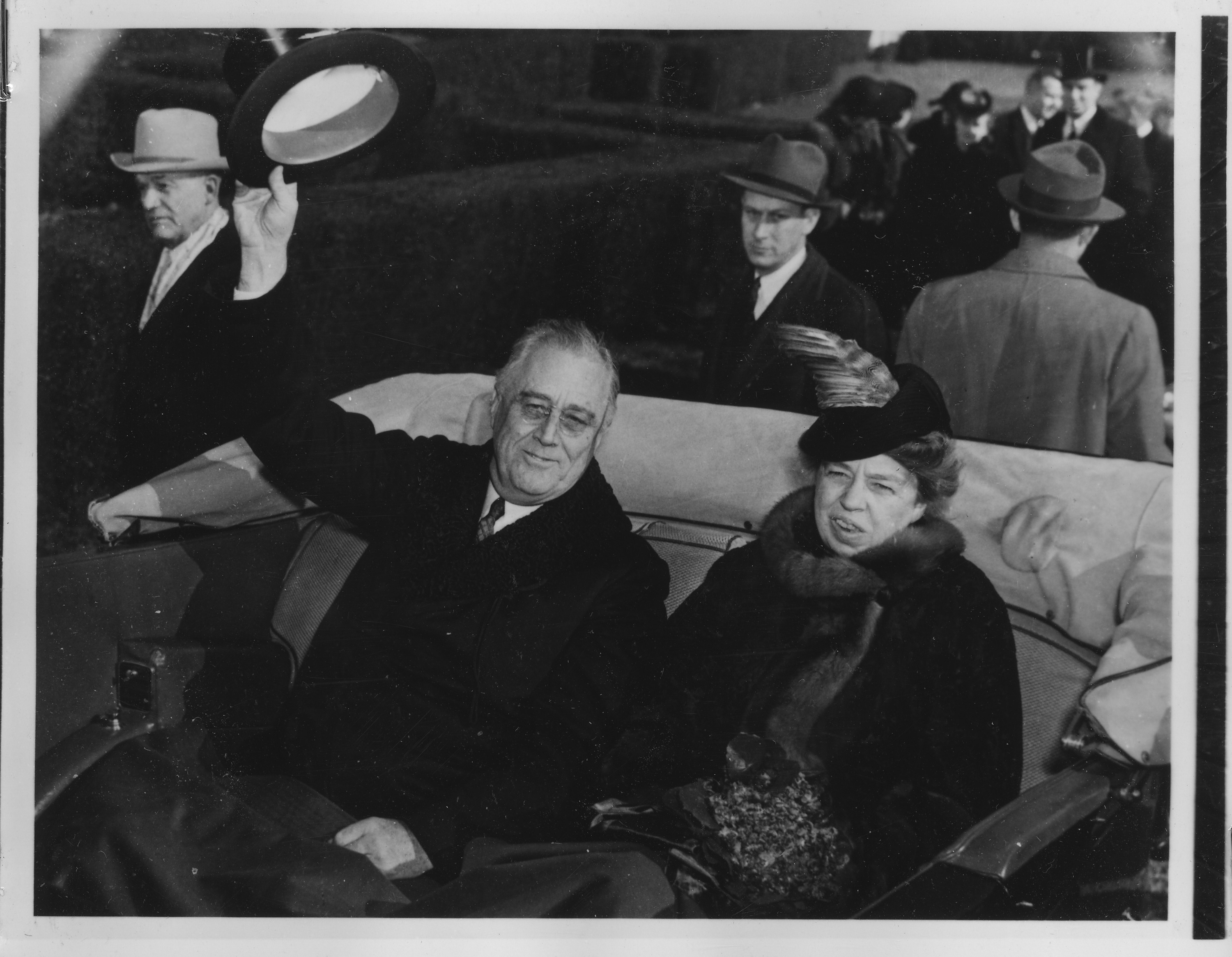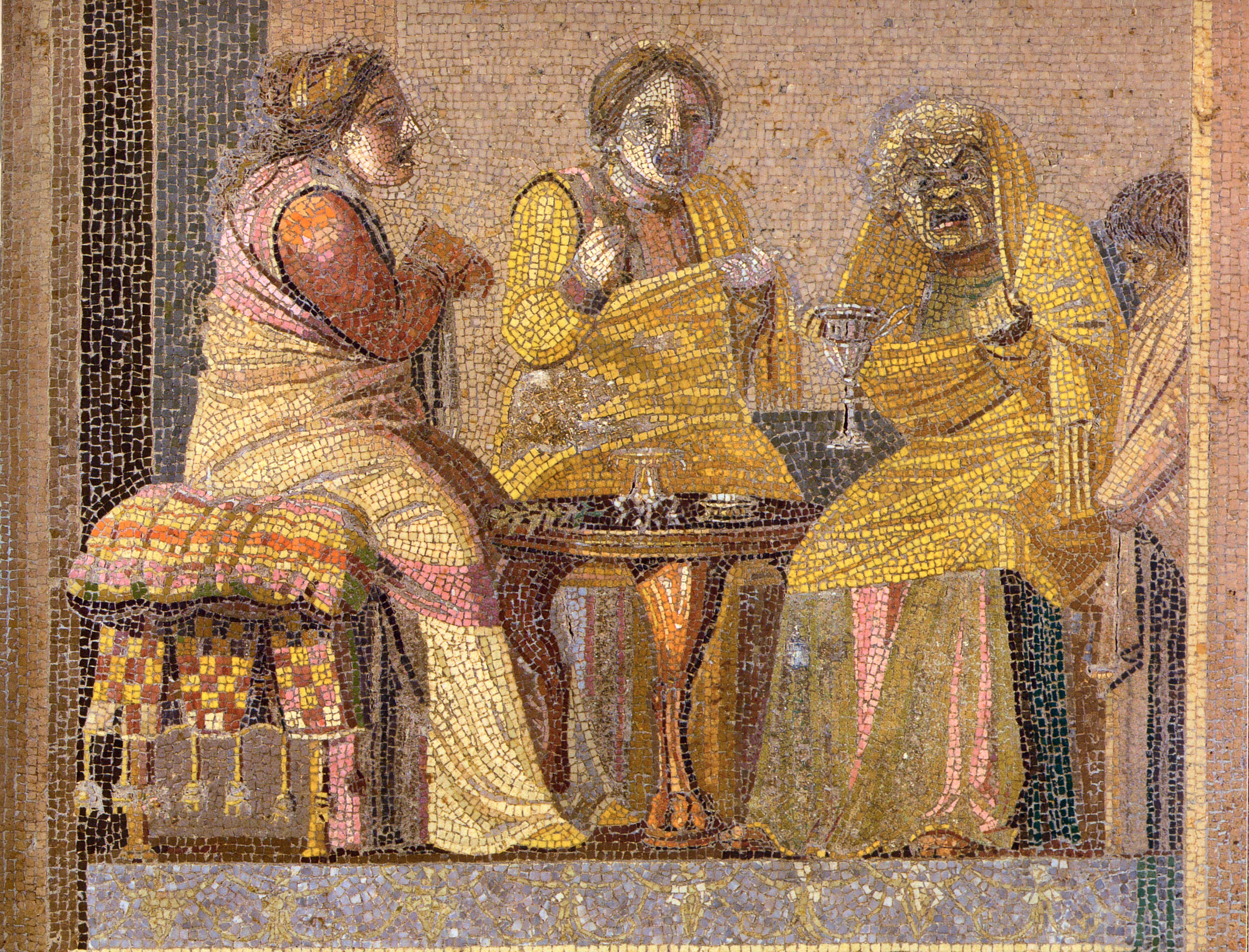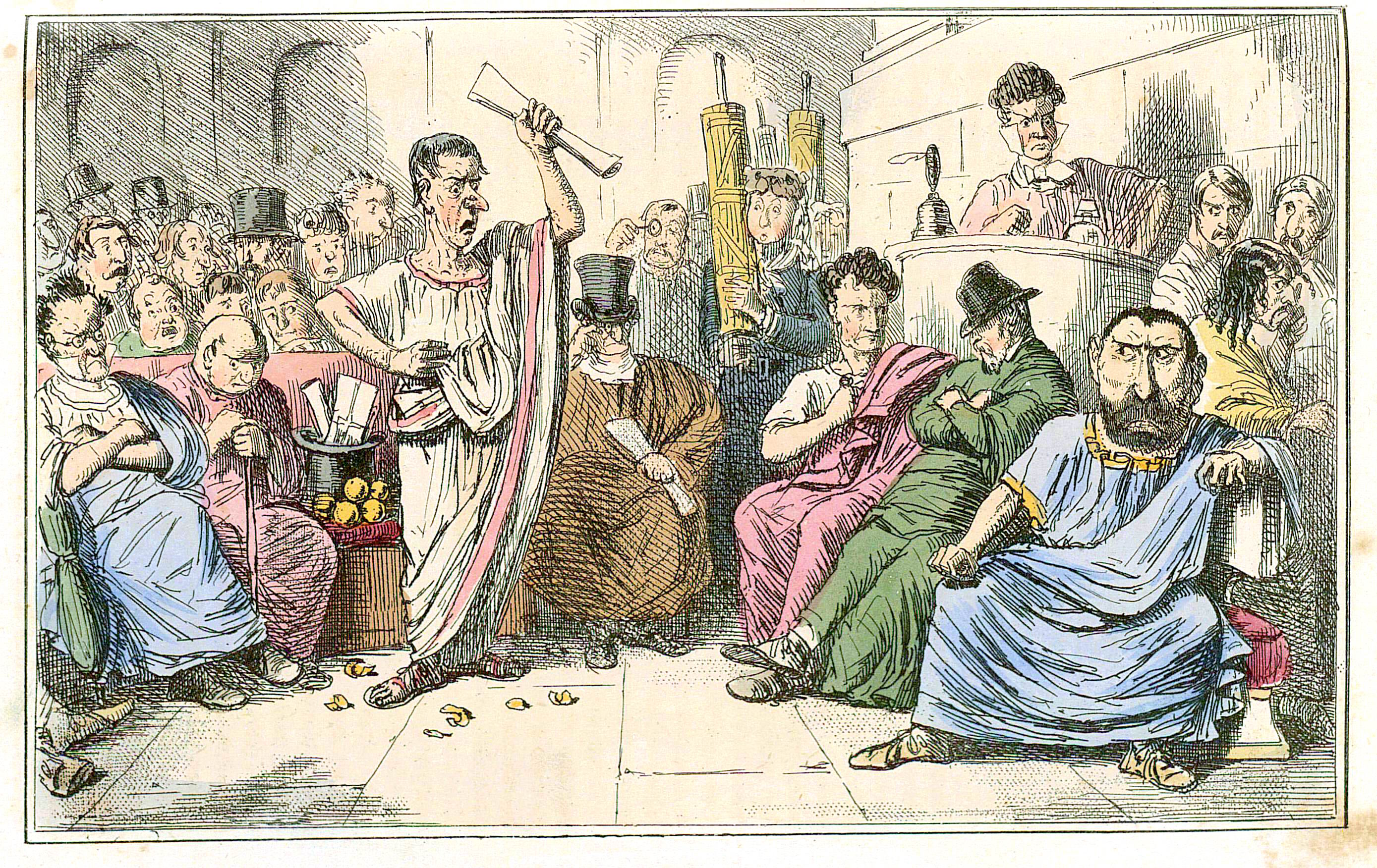Dear Reader, do proceed with caution as this blog entry is a bit wordy today, but there are plenty of pictures as consolation or if you prefer to look rather than read.
 |
| Masters of Modern Art from the Hermitage, the AGNSW Summer Exhibition |
The closest your Correspondent came to a voyage to Russia was in her 20's when an anticipated emigration to England was in the offing. Thinking it would both make for a rather Grand Tour and be a novel way to enter the country, much planning went into a mostly overland journey from Sydney to London, courtesy of The Trans-Siberian Railway. Common sense eventually prevailed when it did dawn on the youthful Pipistrello that it would be in the dead of Winter and not a great deal could be enjoyed from a train window as it would be mostly dark and all would be enveloped in snow. Plus, negative degrees celsius of any magnitude is a fearful thing! So I flew straight to London ... I know ... However, my research provided the basis for a girlfriend's solo summertime journey a couple of years later, so all was not in vain. In the meantime, my purported emigration translated to only a few years away after which circumstances brought me back to Sydney like a homing pigeon and Russia is still yet to be seen in all its glory, snowclad or otherwise.
 |
| Sonia Delaunay-Terk & Blaise Cendrars 1913 'Simultaneous Book' of painting & poetry |
But the intrigue remains and alongside reading about Russia, it was with great delight that Mr P & I took in this summer's exhibition (which has been and gone, obv.) of The State Hermitage Museum's Modern Art Masters, and had a focussed* glimpse into the vast collection of artistic treasures there. My favourites provide today's bit of colour but I must firstly draw your eye to this marvellous piece which has as its text a poem about the poet Blaise Cendrars' journey through Russia on the Trans-Siberian Express. What blogger cannot fail to be drawn to this artwork? It is a prototype of the blog form, is it not? Sonia & Blaise may not have been able to foresee the future, even as Modernists, yet this collaboration between individuals of words and pictures across the same surface, with the images intending to Adorn the Words and convey a sense of movement down the page rather than play their usual book-illustration rôle, was rather ground-breaking in artistic circles a century ago, apparently.
 |
| There are ten different fonts employed in this unusual typographic experiment |
For me, the joy of mucking around on Blogger (and Wordpress, I imagine), alongside it being free and seemingly without rules about content, is the abundance of fonts, and the ability to use colour, play with wallpapers and festoon the page with images of one's own, as well as those from the vast interweb (with, ahem, appropriate copyright in mind, of course), to illustrate a point or just as decoration to one's words, or to find words by others to adorn one's own images. And then to go ahead and Self-Publish, with nary a care as to whether it is appealing or conventional or will find an audience. For someone without an artistic bone in her body, this is enormous fun. And so much better than just writing on a blank journal page, what with my scrappy handwriting and inability to draw.
 |
| The supposed inspiration for the elongated form, the Eiffel Tower, at the conclusion of the poem with its book cover |
Before these electronic notions were freely available to enable even an Artistic Philistine to find some expression, you had to go to Art School, put in countless hours building up a skill set and then, if you were leaning towards Modernism, come up with an New Idea. Sonia's husband was the artist Robert Delaunay and he, being rather infatuated with the Eiffel Tower, had thought she should make the lineal output of the intended limited print run to equal the height of the landmark - a New Idea that didn't quite make it in reality but, nonetheless, no different in ambition to any blogger who is working out the spatial footprint of their own Virtual Sandpit. So I see this piece by the multi-disciplinarian, avante-garde artist Sonia Delaunay-Terk as the Original Hard Copy Blog and like it enormously.
 |
| Camille Pissarro Boulevard Montmartre, afternoon sun, 1897 (detail) |
Anyway, back to the exhibition. The history behind the collection of Masters of Modern Art at the Hermitage is as itself a story as the artwork itself, and Today's Lesson comes from the excellent essay accompanying the irresistible catalogue. The works that made up this State collection's foundation and loaned for this exhibition came principally from two Muscovite private collectors, Sergey Shchukin and Ivan Morozov. They, and their similarly cultured collector-brothers a bit earlier, took a professional approach to buying the "Modern", initially impressionistic, Art emerging in Belle Epoque Paris when their business affairs saw them regularly swooping in. Both men became well known to influential dealers like Paul Durand-Ruel (who acquired the Pissarro above**) and Ambroise Vollard and their respective love affairs with this exciting new style of art grew apace.
 |
| Paul Cézanne Fruit, 1879/80 |
In 1898 Shchukin started his French school collection by buying the likes of Monet, Degas and Denis, then Cézanne, Van Gogh and Gauguin, and eventually gave profile to artists such as Matisse through commssion and Picasso, who had him hypnotised. In 1903 Morozov started his French collection with Sisley, Monet, and Renoir, then commissioned Bonnard and Denis, then collected Matisse and ultimately all the Big Names, with a special fondness for Cézanne. They were friendly rivals and their Moscow mansions filled with extraordinary art as they followed new artistic movements.
| Edouard Vuillard In a room, 1898 |
They bought works from exhibitions in France, from dealers and from the artists directly and Shchukin bought a selection from his own collector brother. They spent large sums, modest sums and occasionally had the joy of Gifts With Purchase from dealers. Their collections rapidly grew to become Museums of modern painting of exemplary quality. Both men sought to introduce Russian society to the fruits of this French avante-garde art. They loaned their works to exhibitions, and opened the private galleries in their mansion homes to the public.
 |
| Odilon Redon Woman asleep beneath a tree, 1900/01 |
This concerted collecting came to a crashing halt with the outbreak of World War I. Then came revolution in Russia and civil war. First Shchukin then Morozov saw their homes with their galleries nationalised into state museums. Both had fled Russia by 1920, leaving everything behind, and their collections were then administered and eventually amalgamated into the Morozov mansion in 1928 as the Museum of Modern Western Art.
 |
| Paul Signac Leaving the Port of Marseilles, 1906/07 |
Up until 1941, when the Soviet Union entered World War II, the cramped conditions saw masterpieces by the likes of Monet, Gauguin and Matisse rubbing shoulders with the work of Proletarian Artists, and then came censorship based upon now long-forgotten political slogans. The museum was closed down entirely in 1948 by Stalin owing to its ideological emptiness and the "damage" it was doing to the development of the official style of Soviet art which was socialist realism, and the collection was divided between the Pushkin Museum and the Hermitage.
 |
| Maurice de Vlaminck View of the Seine, c. 1906 |
Fortunately, the directors of these two museums could see that both a lack of space in the Pushkin museum and the future potential of the artworks' destruction if any was decreed to be antithetic to the proletarian cause was of concern, so they gave the less controversial works to the Pushkin Museum in Moscow and the more than 150 remaining works went into safe storage at the Hermitage in St Petersburg*** until Stalin's decree was repealed after his death.
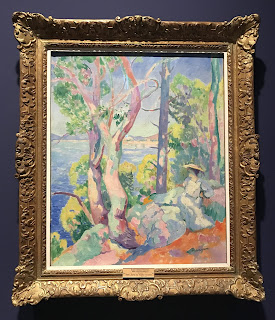 |
| Henri Manguin Morning in Cavalière, 1906 |
Mr P's favourite works, the Wassily Kandinskys shown below had also ended up in storage at the Hermitage after the Russian artist left his most important works at the then Museum of Modern Western Art for safekeeping in 1921 as, although patriotic, he saw that his rejection of realism in his art was not winning him favours and he left for Germany to work with the Bauhaus. While the French avante-garde pictures came back out into public display in the early 1960's, it was only until more recent times that Kandinsky's paintings have joined them.
 |
| Wassily Kandinsky View of Murnau: landscape with a green house, 1908 |
 |
| Wassily Kandinsky Landscape: Dünaberg near Murnau, 1913 |
So, the Hermitage collection of Modern Masters has had quite an exciting short history and obviously some close shaves before the 65 works by 36 artists in the exhibition began wending their way to our shores this summer. In addition to my favourites which are peppering this page (and hopefully not taking too long to load as I've learnt how to compress my photos - another technical milestone!), there was also a painting by the Russian-Australian artist George W. Lambert, who provided the inspiration for last year's Archibald Prize winner, Yvette Coppersmith. And yes, while there are some lovely fingers in The mask, 1911, it didn't make the cut to illustrate this post.
 |
| Henri Rousseau The Luxembourg Gardens, the monument to Chopin, 1909 |
But without doubt, the still-lifes did, including the only Picasso I liked, with its lilac and absinthe-green shades. And to end on a predictable artistic note, let me share with you this happy trio of Pipistrello-endorsed paintings:
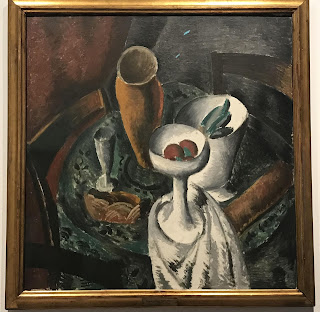 |
| André Derain Table and chairs, 1912 |
 |
| Pablo Picasso Table in a café (Bottle of Pernod), 1912 |
 |
| Amedee Ozenfant Still life, crockery 1920 |
** In checking if these pollarded trees were in fact Platanus x hispanica (London plane trees), I found a marvellous French open-source database where you can identify every tree in Paris, here!
*** If you are interested in such things, the Hermitage Museum has a rather active Instagram account, @hermitage_museum

